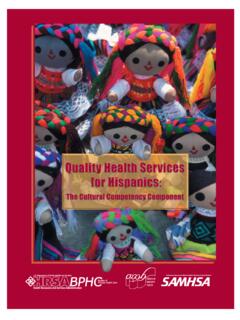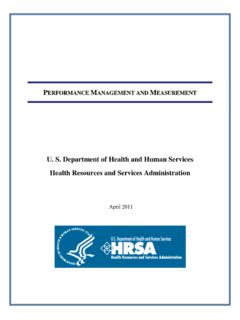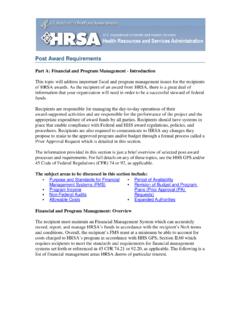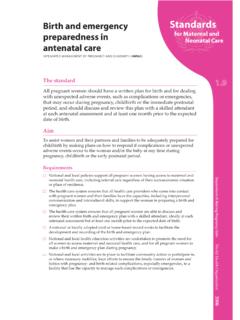Transcription of Maternal Mortality in the United States, 1935 to 2007
1 Maternal Mortality in the United States, 1935-2007: Substantial Racial/Ethnic, Socioeconomic, and Geographic Disparities Persist Gopal K. Singh, PhD. Department of Health and Human Services Health Resources and Services Administration Maternal and Child Health Bureau Figure 1: Maternal Mortality by Race, United States, Figure 2: Maternal Mortality Rate by Race/Ethnicity, 1935 2007 United States, 2005-2007. Trends in Maternal Mortality by Race Maternal Mortality in the United States has declined Maternal deaths are those related to or aggravated by dramatically over the past century (1-4). The rate declined pregnancy or pregnancy management and which occur from Maternal deaths per 100,000 live births in 1915 during or within 42 days after the end of pregnancy (3). to in 2007 (1-3). However, Maternal Mortality in the Although Mortality trend data extend farther back in time United States has changed very little in the past 25 years for the entire United States and the birth registration area (1, 3).
2 Achieving further reductions in the Maternal Mortality (1, 2), we chose 1935 as the start of the time trend analysis rate is an important public health priority for the nation as since it coincided with the inception of Title V of the Social the rates for certain ethnic minority and socioeconomic Security Act, a national public health legislation aimed at groups remain relatively high (3, 4, 5). A cross-national promoting and improving the health and welfare services comparison of the 2005 statistics by the World Health for all mothers and children. The Maternal Mortality rates in Organization (WHO) reveals that the rate of 15 mater- the United States showed a consistently downward trend nal deaths per 100,000 live births exceeded the rates for at between 1935 and 1982, decreasing at a rapid rate of least 41 other countries, including Canada, Australia, Japan, per year (Figure 1).
3 During 1935-1982, the rate of decline and all the Western and Northern European countries (6). in Maternal Mortality was significantly faster among white In this brief report, we analyze long-term trends in women than among black women. The risk of Maternal Maternal Mortality according to race/ethnicity, socioeco- Mortality remained 3 to 4 times higher among black women nomic position (family poverty level), and state and region than white women during the past 6 decades (Figure 1). of residence by using both historical and the latest national The trend in Maternal Mortality from 1982 through 1998 was vital statistics data (2, 3). As shown below, despite the fairly stable barring yearly fluctuations, but since 1999, there massive drop in Maternal Mortality over the long term, appears to be an upturn in Maternal Mortality among both substantial racial/ethnic, socioeconomic, and geographic white and black women, which has partly been attributed to disparities remain, with many of the sociodemographic changes in the coding and classification of Maternal deaths groups currently far from achieving the national goal for the resulting from the implementation in 1999 of the Interna- year 2010 (7).
4 Tional Classification of Diseases, 10th Revision (ICD-10) in the United States. Figure 3: Maternal Mortality Rate by County-Level Family 100,000 live births was highest among non-Hispanic black Poverty Rate, United States, 1969-2007 women ( ), followed by American Indians/Alaska Natives ( ), Asian/Pacific Islanders ( ), non-Hispanic whites ( ), and Hispanics ( ) [Figure 2]. Trends in Socioeconomic Disparities in Maternal Mortality Since reliable socioeconomic data are lacking on death certificates, which are the basis for the national Mortality statistics, county-level family poverty data from the 1990. and 2000 censuses were linked with county-level Mortality data to compute Maternal Mortality rates from 1969 to 2007. in three poverty rate categories: <5% ( , less than 5% of families below the poverty level in a county, referred to as the low poverty group), (middle poverty group), and 15% or higher (high poverty group) [3, 8, 9].
5 Details of the linkage methodology are provided elsewhere (10). During 1969-2002, the Maternal Mortality rate for women in the low poverty group declined by 41%, whereas the rate for women in the middle and high poverty groups decreased by and , respectively (Figure 3). The faster Figure 4: Relative Risk of Maternal Mortality by County-Level Family Poverty Rate, United States, 1969-2007 decline in Maternal Mortality among higher poverty groups contributed to the narrowing of the socioeconomic differen- tials in Maternal Mortality . Note that the Maternal Mortality rate increased significantly between 1999-2002 and 2003- 2007 for women in all socioeconomic groups. All relative risks of Mortality for the poverty groups were statistically significant. Compared to women in the low poverty group, women in the middle poverty and high poverty groups had 90% and 220% higher Maternal Mortality risks in 1969-1971.
6 And 58% and 102% higher Maternal Mortality risks in 2003-2007, respectively (Figure 4). Higher poverty rates were associated with higher Maternal Mortality risks among both white and black women in each time period (data not shown). For example, in 2003-2007, black women in the high poverty group had a 35% higher Maternal Mortality rate than black women in the low poverty group. For white women, the corresponding relative risk of Mortality was 50%. higher in the high poverty group compared to the low pov- erty group. Moreover, within each poverty group, significant racial disparities in Maternal Mortality existed, with black In 2007, the Maternal Mortality rate for black women was women experiencing an approximately three times higher deaths per 100,000 live births, times higher than Maternal Mortality risk than white women in each poverty the rate for white women ( ).
7 According to the 2005-2007 group (data not shown). detailed racial/ethnic data, the Maternal Mortality rate per Figure 5: Maternal Mortality Rate per 100,000 Live Births, 2003-2007. Figure 6: Maternal Mortality Rate by Geographic Region, United States, 2003-2007. Geographic Disparities in Maternal Mortality England, the risk of Maternal Mortality was times higher During 2003-2007, the Maternal Mortality rate varied among women in the Mid-Atlantic region, times higher considerably by state of residence, ranging from a low of in the South Atlantic region, times higher in the West deaths per 100,000 live births for Indiana to a high of South Central region, and times higher in the Pacific for the District of Columbia and for Michigan (compari- region. Excess Maternal Mortality risks in the Mid-Atlantic, son based on only those states where a total of at least 16 Southern, and Pacific regions existed among both white and Maternal deaths occurred during 2003-2007) [Figure 5].
8 Black women (data not shown). The states with at least 50% (and statistically significantly) In a state-level ecological analysis, higher levels of higher Maternal Mortality rates than the national average poverty rates, percentage of immigrant population, and include the District of Columbia, Michigan, Oklahoma, cesarean rates were independently associated with higher Idaho, New Jersey, Maryland, New York, and Mississippi. Maternal Mortality rates. Specifically, states, in which pov- Maine, Alaska, North Dakota, Indiana, Massachusetts, erty rates exceeded 18%, immigrant population exceeded Illinois, Minnesota, and Rhode Island had at least 50% (and 15%, and cesarean rates exceeded 33%, had 77%, 33%, statistically significantly) lower Maternal Mortality rates than and 21% higher risks of Maternal Mortality , respectively, the national average (Figure 5).
9 Women in all regions had than states with lower rates of poverty, immigration, and significantly higher risks of Maternal Mortality than women cesarean deliveries (data not shown). in New England (Figure 6). Compared to women in New Discussion (3, 4). In pregnancies with abortive outcomes, ectopic preg- Reducing the overall Maternal Mortality rate as well as nancy is the leading cause of Maternal death (3, 4). While the associated racial/ethnic and socioeconomic disparity Maternal Mortality from hemorrhage, pregnancy-induced is an important health objective for the nation (7). The hypertension, and embolism has declined during the past long-term trend from 1935 to 1982 indicates a dramatic two decades, Maternal deaths due to other medical condi- decline in the Maternal Mortality rate. However, the tions, including cardiovascular and neurological problems, recent trend appears to indicate a substantial increase in appear to have increased (4).
10 The rising trend in cesarean Maternal Mortality rates, some of which could be attributed rates may have also contributed to the apparent increase to recent coding and classification changes (1, 3). With the in Maternal Mortality during the past decade. The cesarean implementation of ICD-10 effective with Mortality statistics delivery rate in the United States has risen by more than in 1999 and thereafter, additional deaths due to indirect 50% during the past decade, from in 1996 to Maternal causes of death have begun to be included in the in 2007 (11). Complications of cesarean sections have been official Mortality statistics, which would not have otherwise associated with increased Maternal Mortality , and a recent been classified as Maternal deaths in the previous ICD revi- study indicates 8 to 10 times higher Maternal Mortality risks sions (1, 3). In addition, a number of states have, in recent for cesarean delivery compared with vaginal birth (12).













